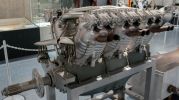
Selected Early Engines
Lawrance, Le Rhône, , Liberty, Lorraine-Dietrich
Compiled by Kimble D. McCutcheon
Published 1 Sep 2022; Revised 13 Oct 2022
Lorraine-Dietrich
The Societé Lorraine was organized by Jean de Dietrich in 1864, with the Dietrich & Cie shops at Jaggerthal and the ironworks at Reischoffen. Shops in Niederfrolin followed in 1869 and Luneville factories opened in 1880. As the largest French engineering establishment, its chief products were rails and railway equipment. Automobile manufacturing began in 1893. To address business expansion, a separate company was formed in 1905, and a factory at Argenteuil constructed in 1907. This factory was turned over to aircraft engine production in 1915 to meet the demand for reliable WWI engines. First known as the Societé Generale Acronautique, headquartered at 11 Rue de Tilsitt, Paris, France. This was later known as the Societé des Moteurs et Automobiles Lorraine, a subsidiary of Societié Nationale de Construction de Moteurs. Later still, it was known as the Societé Nationale de Construction de Moteurs, 204 Rue Henri Barbusse, Argenteuil, France. Many Lorraine-Dietrich enginetypes were built during WWI, and became well known for their reliability. Aircraft engine manufacturing was continued after WWI, with 12- and 18-cylinder V- and W- engines predominant. Air-cooled radials were added in 1926.
Inline Sixes
Lorraine-Dietrich, under the direction of Engineer Marius Barbarou, first created an inline six, similar to the Mercedes design, which was designed in 1914 and installed in service aircraft during 1915. This Aviation Militaire A.M. 6A, with a 120 mm (4.724") bore, 140 mm (5.512") stroke, 9.500 l (917.93 in³) displacement and 4.5:1 compression ratio produced 100 hp at 1,650 rpm and weighed 165 kg (364 lb). Production reached 200 units.
V-8s
Two water-cooled 90° V-8s with 120 mm (4.724") bores, 140 mm (5.512") strokes and 12.667 l (772.99 in³) displacements followed the A.M. 6A during 1915. The 8Aa was rated 150 hp at 1,500 rpm; 15 were produced. The 8Aby was rated 170 hp at 1,650 rpm and weighed 225 kg (496 lb); 300 were produced.
In 1917, the stroke was increased to 170 mm (6.693") to meet the demand for higher power. With its 15.381 l (938.61 in³) displacement, the 8Ba was rated 220 hp at 1,350 rpm and developed 245 hp at 1,500 rpm and 275 hp at 1,750 rpm. It weighed 245 kg (540 lb); 90 were produced.
The 8Bb, a water-cooled 90° V-8 with a 120 mm (4.724") bore, 170 mm (6.693") stroke and 15.381 l (938.61 in³) displacement introduced in 1917 was rated 240 hp at 1,700 rpm and weighed 250 kg (551 lb); 30 were produced.
The 8Bd and 8Be, both water cooled 90° V-8s introduced in 1918 with 120 mm (4.724") bores, 180 mm (7.087") strokes, 16.286 l (993.83 in³) displacements and 4.7:1 compression ratios, were rated 270 hp at 1,900 rpm. Dry weight was 260 kg (573 lb) and 50 were produced.
The Type 15-2, a later Type 8Bd/e V-8 development with the same 120 mm (4.724") bore, 180 mm (7.087") stroke and 16.29 l (993.83 in³) displacement introduced in 1917 but with a 5.2:1 compression ratio, was rated 270 hp at 1,650 rpm and weighed 289 kg (638 lb).
The Type 16, another water-cooled V-8 with a 120 mm (4.724") bore, 180 mm (7.087") stroke and 16.29 l (993.83 in³) displacement, was rated 300 hp and weighed 248 kg (547 lb).
V-12s
 |
| 12D (Wiki) |
The 12D engine series, an improvement on the 8B series, were water-cooled 60° V-12s with 120 mm (4.724") bores, 180 mm (7.087") strokes and 24.429 l (1,490.75 in³) displacements.
The 12D, released in 1916, was rated 370 hp at 1,650 rpm and weighed 363 kg (800 lb); 50 were produced.
The 12Da, released in 1917, was rated 400 hp at 1,700 rpm and weighed 420 kg (926 lb); 400 were produced.
The 12Db, released in 1918, had a 5.5:1 compression ratio, was rated 400 hp at 1,700 rpm and weighed 409 kg (902 lb); 850 were produced. Fuel and oil consumptions were 0.51 and 0.03 lb/hp/hr. It was 63.1" long, 31.3" wide and 40.5" high. With propeller reduction gears, the engine was rated 400 hp at 1,800 rpm and weighed 439 kg (968 lb).
The 12Dc, released in 1919, produced 370 hp; 100 were built.
Experimental Evolutionary V-12s
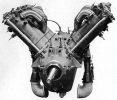 |
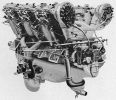 |
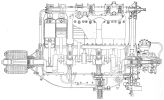 |
 |
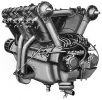 |
| Lorraine-Dietrich Early 12E Series (AEE) | Type 13 (AEE) | |||
The 12Rcr Radium was an inverted water-cooled V-12 designed in 1930 for the 1931 Schneider Trophy Races. With a 145 mm (8.709") bore and stroke and a 28.733 l (1,753.37 in³) displacement, it produced a whopping 2,200 hp at 3,900 rpm and weighed 512 kg (1,129 lb), for a specific weight of 0.51 lb/hp. Its supercharger impeller ran at 28,000 rpm.
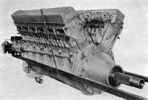 |
| Lorraine 12Q (A39) |
The 12Q Eider, introduced in 1930, was a water-cooled 60° V-12 with a 170 mm (6.693") bore, 165 mm (6.496") stroke and 44.942 l (2,742.53 in³) displacement that was rated 900 hp at 2,200 rpm and developed 1,050 hp at 2,200 rpm. The direct drive version weighed 579 kg (1,276 lb), was 1,885 m (74.63") long, 750 mm (29.52") wide, and 960 mm (37.79") high. The geared version was 1,950 mm (76.77" long and weighed 626 kg (1,397 lb). The 12Q used wet cylinder liners screwed and shrunk into a six-cylinder aluminum alloy casting, with the barrels extending deep into the crankcase casting. The water jacket was sealed at the cylinder barrel inner ends. Dual overhead camshafts running in shallow aluminum castings bolted atop the cylinder blocks operated four vertical valves in each cylinder. The valve mechanism was enclosed by an aluminum cover. There were four spark plugs in each cylinder, and the inlet manifolds were arranged in the Vee.
The 12Qo Eider, introduced in 1936, had a 170 min. (6.693") bore and stroke, and a 46.304 l (2,825.64 in³) displacement. It delivered 1,000 hp at 2,350 rpm and 4,000 m (13,000 ft) altitude and weighed 740 kg (1,631 lb). Propeller reduction gear ratio was 17:11 and 5 were produced.
 |
 |
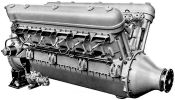 |
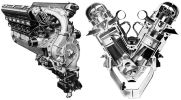 |
| 12H Petrel (A39) | 12Hfrs (Lorraine-Dietrich) | ||
The 12H Petrel engine series, released in 1930, consisted of water-cooled, direct-drive or geared, supercharged, 60° V-12s with 145 mm (5.709") bores and strokes, resulting in 28.733 l (1,753.39 in³) displacements. The original 12H normal rating for both direct-drive and geared types was 500 hp at 2,250 rpm. The direct-drive engine produced 675 hp at 2,200 rpm; the geared engine produced 702 hp at 2,200 rpm. The 1930 geared and supercharged 12Hars produced 700 hp at 3,000 rpm and weighed 650 kg (1,433 lb); 65 were produced. The 1931 geared and supercharged 12Hdrs geared and supercharged produced 720 hp at 2,300 rpm and weighed 635 kg (1,400 lb); 350 were produced. The 1934 geared (17:11) and supercharged 12Hers with its 6.0:1 compression ratio was rated 720 hp at 2,650 rpm, a power level that was maintained up to 4,000 m (13,000 ft). The 12Hers weighed 474 kg (1,045 lb), was 1,859 mm (73.14") long, 795 mm (31.29") high and 709 mm (27.90") wide. The 1935 geared and supercharged 12Hfrs and 12Grs with their 7.0:1 compression ratios produced 815 hp at 2,800 rpm and weighed 650 kg (1,433 lb); 50 were produced.
Petrel construction was similar to the Eider. Six steel cylinder barrels were screwed into an aluminum alloy block casting, creating a wet-liner construction. However, part of the water jacket was formed in the extension of the Elektron crankcase, to which the block was attached. This meant that no coolant inlet pipes were disturbed when a cylinder block was removed. Four vertical valves in each cylinder operated in pairs through a guided bridge-piece from overhead camshafts. Each block carried an inlet and an exhaust camshaft, both driven from the crankshaft by a vertical shaft and bevel gears. The cam operating mechanism was fully enclosed and pressure lubricated. The aluminum alloy pistons and had four compression rings fitted above the piston-pin and an oil-scraper ring below. Articulated connecting rods were used. The balanced six-throw crankshaft was mounted in seven bearings; a flange at the crankshaft front simplified conversion from direct-drive to geared by the changing the nose piece. Lorraine planetary reduction gears operated at a 17:11 ratio. Fuel, oil and water pumps were grouped at the engine aft bottom. Two magnetos and distributors provided dual ignition. A Lorraine-designed centrifugal supercharger was driven through a planetary gear train at an 8.4:1 ratio. The compressor inlet passage had an aft ventral flange to which a Stromberg carburetor was attached.
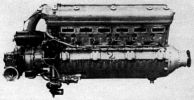 |
 |
| Lorraine-Dietrich 12R Sterna (A39) | |
The 12R Sterna engine appeared in 1936, as a refined and enlarged Petrel. Bore and stroke were 148 mm (5.827"), and the displacement was 30.553 l (1,864.47 in³). The 12R's normal output with a 6:1 compression ratio, boosted by supercharging, was 810 hp at 2,575 rpm and 4,000 m (1,3000 ft), and the use of special fuel delivered 1,100 hp. Sea level takeoff rating was 1,350 hp at 3,000 rpm. The improved output is largely results from better induction. The dual centrifugal supercharger mounted at the engine aft provided a circular track for the mixture. The planetary reduction gear for the propeller had a 17:1 ratio. Engine dry weight was 502 kg (1,106 lb).
A later Type III Sterna had a normal rating of 900 hp at 2,700 rpm and 4,000 m (13,000 ft). The takeoff output was 1,200 hp. The compression ratio was raised to 7:1, and the supercharger turned 8.8 times crankshaft speed. Fuel and oil consumptions were 0.484 and 0.0264 lb/hp/hr. Dry weight was 509 kg (1,122 lb.)
The two-piece aluminum crankcase supported the seven-main-bearing crankshaft. Articulated connecting rods had H-section shanks and the forged aluminum alloy pistons were fitted with three compression rings and two oil-scraper rings. There were four camshafts and four valves per cylinder. The two-speed Lorraine supercharger had a steel impeller and automatic control, and AM type 14CM fuel pumps supply fuel to two Lorraine horizontal carburetors. Provisions existed for mounting 300 and 1,200 watt electric generators.
The Sterna engine was developed to serve five forms. All were water-cooled upright V-12s with 148 mm (5.827") bores and strokes and 30.553 l (1,864.47 in³) displacements. The Type 1° used a reduction gear that could be changed for either clockwise or anti-clockwise propeller rotation. The Type 2° employed 34:21 reduction gearing that placed the hollow propeller shaft axis above the crankshaft where a cannon mounted in the Vee could be fired through it. The Type 3° had a two-stage two-speed supercharger that permitted an output of 900 hp at 1,800 m (5,900 ft) and an output of 850 hp at 4,500 m (13,800 ft). Supercharger gear ratios 5.14:1 and 8.8:1 were employed. Type 4° provided for direct fuel injection and a Planiol supercharger to attain better scavenging. Type 5° provided for a remote propeller drive, and offset reduction gearing for driving two propellers in opposite directions.
W-12s
Lorraine-Dietrich began experimenting with three-row 'W' engines toward WWI's end. The 'W' configuration offered several advantages of decreased weight and increased rpm. However, the W-engine disadvantages, especially with 18-cylinders, was the relatively narrow 40° bank spacing, which left little room for manifolds and accessories. If an 80° bank spacing was employed, the result was an overly-wide engine at a time when everyone was obsessed with minimal frontal area.
The Type 14, a water-cooled 60° W-12, had Type 12E cylinder dimensions - 120 mm (4.724") bore, 170 mm (6.693") stroke and 23.072 l (1,407.93 in³) displacement. Its output was 358 hp at 1,500 rpm and 422 hp at 1,800 rpm.
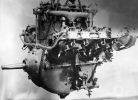 |
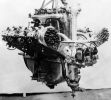 |
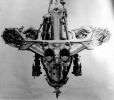 |
| Lorraine-Dietrich Type 15 (NARA) | ||
The Type 15 was a water-cooled 60° W-12 with a 120 mm (4.724") bore, 175 mm (6.890") stroke, and a 23.750 l (1,449.34 in³) displacement that delivered 370 hp at 1,500 rpm and 435 hp at 1,800 rpm. Weight was 326.8 kg (720 lb), or 1.94 lb/hp. The four-throw crankshaft was supported in three plain main bearings, and the connecting rods employed tubular shanks. The two outer rods had their bearings on the master connecting rod outer surface for somewhat less than half their circumference, and were held to it by two circular rings bolted together longitudinally. The engine was equipped with three carburetors, one for each four-cylinder bank.
The Type 12Eb, released in 1922, was a water-cooled 60° W-12 with a 120 mm (4.724") bore, 180 mm (7.087") stroke, 24.429 l (1,490.75 in³) displacement and 6:1 compression ratio. It was rated 450 hp at 1,850 rpm, developed 478 hp at 1,880 rpm, weighed 389.2 kg (858 lb), and was 1,299 mm (51.14") long, 1,204 mm (47.4") wide and 1,105 mm (43.5") high. Fuel and oil consumptions were 0.51 and 0.01 lb/hp/hr.
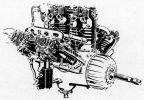 |
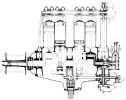 |
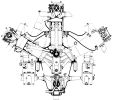 |
| Type 12Ed (A39) | ||
The Type 12Ed was similar to the Type 12Eb, except for 17:11 propeller reduction gearing and length increase to 1,524 mm (60.0"). It was rated 450 hp at 1,900 rpm and developed 490 hp. The compression ratio was 6.0:1, and the weight was 424.1 kg (935 lb).
The Type 12Ee was a Type 12Eb with a 6.5:1 compression ratio. Its rated output was 480 hp at 2,000 rpm, but it produced 510 hp. Weight was 383.7 kg (846 lb).
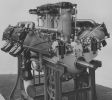 |
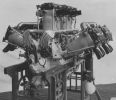 |
| Lorraine-Dietrich 12Fb (A39) | |
The Type 12F, designed in 1918, was a water-cooled 60º W-12 with a 126 mm (4.961”) bore, 180 mm (7.087”) stroke, 26.933 l (1,643.55 in³) displacement and 5.2:1 compression ratio that produced 500 hp at 1,600 rpm and weighed 435 kg (960 lb). Its two-piece aluminum alloy crankcase was split horizontally along the crankshaft axis. Each cylinder bank had two cylinder pairs with welded steel water jackets. Enclosed single inlet and exhaust valves were actuated by rocker arms, push rods and two camshafts, each positioned in the Vee between cylinder banks. Outboard cylinder bank exhaust valves had roller rockers that followed the camshaft. The four-throw flat-plane crankshaft ran on three main bearings. A master connecting rod attached each crankpin to the center cylinder bank aluminum alloy pistons; articulated rods in the outboard cylinder banks connected the master rod to pistons. The master rods connected to aluminum pistons in the vertical cylinder bank. Articulated rods connected the pistons in the outboard cylinder banks to the master connecting rods. A single-barrel updraft carburetor outboard of the right cylinder bank fed that bank’s cylinders. A two-barrel carburetor on the left side fed both the left and center cylinder banks. Each cylinder had two spark plugs fired by two magnetos located aft. The left magneto fired intake-side spark plugs, and the right magneto fired exhaust-side plugs.
As WWI ended, a 60° W-12 with a 126 mm (4.961") bore, 200 mm (7.874") stroke and 29.926 l (1,826.17 in³) displacement, was offered. Rated 500 hp, it developed 525 hp at 1,600 rpm and weighed 435 kg (959 lb), or 1.92 lb/hp. Its four-throw crankshaft was supported in three plain main bearings. Two camshafts were situated in the Vee, one either side of the vertical cylinder row.
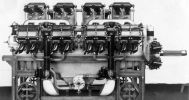 |
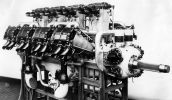 |
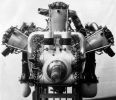 |
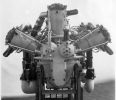 |
| Lorraine-Dietrich 12G W-24 (NARA) | |||
The Type 12G, a 60° W-24 first displayed in 1919, used 12F (the 1919 one) cylinders, connecting rods, and other components, but introduced a new crankcase, eight-throw, five-main-bearing, two-plane crankshaft, camshafts and ignition drive. The 12G, with its 126 mm (4.961") bore, 180 mm (7.087") stroke and 53.866 l (3,287.10 in³) displacement, was rated 1,000 hp at 1,600 rpm and weighed 850 kg (1,874 lb), or 1.87 lb/hp. Carburetors were located on the outside, and two oil pumps from the smaller 12F were fitted. The crankcase space between the center and each outer cylinder row was occupied by a camshaft. Two Delco generators powered four 12-contact distributors, which supplied ignition. Compressed air applied to the six aft cylinders started the engine.
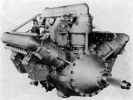 |
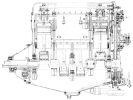 |
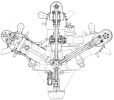 |
| 12F Courlis (A39) | ||
The 12F Courlis series, a reuse of the 12F designation for a new engine, was a water-cooled W-12 introduced in 1929. The four-cylinder heads and water jackets were a single aluminum alloy casting into which steel cylinder barrels were screwed, forming wet liners that were sealed at the lower ends by stuffing-box joints, thus forming a single four-cylinder block attached to the crankcase by each barrel's flanges. Four vertical valves in each cylinder were operated in pairs through a guided bridge piece from the enclosed overhead camshaft, which was carried in aluminum bearings bolted to the cylinder block. Vertical drive shafts with pressure-fed bearings and bevel gears drove the camshafts. The crankshaft was carried upon two plain bearings, two roller bearings, and two fore-and-aft ball bearings with the fore bearing taking the propeller thrust load. All except the front bearing were supported by aluminum bearing caps. The front ball bearing was supported in a nose piece that featured a universal crankshaft flange attachment that permitted the engine to be either direct-drive (the 12Fb) or with planetary propeller reduction gears (the 12Fa). The H-section master rods had caps secured by six studs and nuts; H-section articulated rods were attached to either master rod side. The aluminum alloy pistons had cross-wise ribs underneath the head, and carried four rings above and an oil-scraper ring below its full-floating piston-pin. Oil was introduced into the crankshaft at the plain bearings which were located at the center positions, the pressure being supplied by a gear pump situated in a group including the fuel and centrifugal water pumps. Either battery or magneto ignition was available. A triple-throat Stromberg carburetor supplied the mixture. The 12Fa and 12Fb bores were 145 mm (5.709"), the strokes 160 mm (6.299"), and the displacements 31.705 l (1934.75 in³). All versions were rated 600 hp at 2,000 rpm and produced 660 hp at higher speed. The direct-drive engine weighed 424 kg (935 lb), and the geared model weighed 463 kg (1,020 lb). Length was 1,651 mm (65"), width was 1,143 mm (45"), and height was 1,067 mm (42").
The 12E Hibis, announced in 1932, was an updated 12Eb that incorporated 12F-series features, including aluminum-alloy four-valve heads similar to 12F series heads. With a 122 mm (4.803" bore), 180 mm (7.087") stroke, 25.250 l (1,540.86 in³) displacement and 6.0:1 compression ratio, it was rated 450 hp at 1,800 rpm, but produced 500 hp at 2,000 rpm. Tne direct-drive version weighed 390 kg (860 lb) while the geared version weighed 425 kg (937 lb). Both versions were 1,565 mm (61.61") long, 1,246 mm (49.05") wide and 1,060 mm (41.75") high. Fuel and oil consumptions were predicted at 0.51 and 0.01 lb/hp/hr. Four Zenith carburetors were used.It is doubtful that any of this model were actually produced.
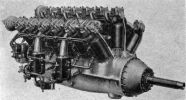 |
| Lorriane-Dietrich 18Kd (A39) |
The Type 18Kd was a geared Type 18Ka, rated 650 hp at 2,000 rpm and developing 740 hp at 2,000 rpm. Fuel and oil consumptions were 0.49 and 0.015 lb/hp/hr. It was 2,134 mm (84") long, 1,021 mm (40.2") wide, 920 mm (36.2") high and weighed 619 kg (1,365 1b).
The 18Ga Orion, a water-cooled, 60° W-18, was first displayed at the 1930 Paris Aeronautical Exhibition. With a 125 mm (4.921") bore, 180 mm (7.087") bore, 39.761 l (2,426.35 in³) displacement and 6.0:1 compression ratio, it was rated 700 hp at 2,100 rpm. A planetary propeller reduction gear using six planet gears provided a 17:11 ratio. Dry weight was 568 kg (1,252 lb); the 18Ga was 2,106 mm (82.91") long, 906 mm (35.66") wide and 1,105 mm (43.49") high. Its steel cylinders had welded-on water jackets. The screwed-on aluminum alloy cylinder heads each had four vertical valves seating upon screwed-in aluminum-bronze inserts. These valves were operated from a single overhead camshaft through a T-shaped follower for each valve pair. The hollow follower stems were guided in screwed-in bronze bushings that located in the aluminum brackets that supported the camshafts. Pressurized camshaft bearing lubricating oil was led into the follower bushings through drilled passages. This not only lubricated the follower bushings, but also delivered oil to the cam faces when the followers were depressed. Stromberg carburetors were fitted to each cylinder pair.
The 1934 18G Super Orion was rated 1,050 hp at 2,150 rpm, which a supercharger could maintain up to 1,500 m (4,921 ft). A 17:11 reduction gear was provided. The 18G Super Orion weighed 627 kg (1,382 1b), was 2,088 mm (82.22") long, 960 mm (37.79") wide and 1,135 mm (44.68") high.
Radials
In 1926, Lorraine-Dietrich started an air-cooled radial engine line, which appears to have been initially based on Armstrong-Siddeley Lynx and Jaguar designs. Composite cylinders were built from open-ended steel barrels with integral cooling fins were screwed into cast aluminum alloy heads and locked by a ring nut that wedged the joint when tightened. Trunk-type aluminum alloy pistons featured floating pins retained end-wise by spring clips. The master rod had an H-section shank, and the link rods tubular shanks. The split master rod big end was secured by four bolts, and captured a white-metal-lined bronze bearing. Both single and two-throw crankshafts were machined from one-piece forgings and fitted with bolted-on counterweights. The aluminum crankcases were made with a rear opening through which the connecting rods and crankshaft were inserted as a unit. The front wall crankcase wall carried the front crankshaft bearing and a cam gear housing enclosing a double-track cam ring driven by an epicyclic gear train. Roller tappets guided by the crankcase operated the valves through ball-ended push rods and rocker arms with ball bearings. Magnetos were mounted on this front housing and driven by a bevel gear carried on the cam ring planet wheel cage. A dry-sump pressure-fed lubrication system was employed.
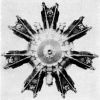 |
| 7Ma (A39) |
The Model 47 (later 7Ma, 7Mb) was an air-cooled 7-cylinder radial with a 135 mm (5.315") bore, 150 mm (5.906") stroke, 30.059 l (1,834.3 in³) displacement and 5.0:1 compression ratio rated 240 hp at 1,800 rpm, but producing 280 hp at 1,900 rpm. Fuel consumption was 0.55 lb/hp/hr. Weight was 270 kg (595 lb), outside diameter was 1,245 mm (49") and length was 1,194 mm (47.0"). A single Zenith carburetor supplied mixture to the annular chamber in the rear cover that carried a centrifugal distribution fan. Thirty were made.
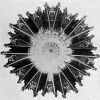 |
| 14Ac (A39) |
The Model 42 (later 14Ac Antares) was an air-cooled 14-cylinder two-row radial with a 135 mm (5.315") bore, 150 mm (5.906") stroke, 30.059 l (1,834.3 in³) displacement and 5.0:1 compression ratio rated 470 hp at 1,800 rpm, but producing 550 hp at 1,860 rpm. Fuel consumption was 0.528 lb/hp/hr. Weight was 439 kg (968 lb), outside diameter was 1,245 mm (49") and length was 1,359 mm (53.5"). This engine was in essentially a double Model 47 with most parts interchangeable. The mixture from a duplex carburetor entered an annular chamber in the rear cover and was distributed to the individual pipes connected to each cylinder by a centrifugal fan. Fifteen were made.
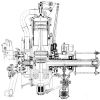 |
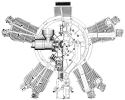 |
| 5Pa (A39) | |
The Model 49 (later 5P series) was an air-cooled five-cylinder radial with a 125 mm (4.921") bore, 140 mm (5.512") stroke, 5.0:1 compression ratio and 8.59 l (524.2 in³) displacement. It was rated 100 hp at 1,350 rpm but produced 107 hp. Weight was 155 kg (342 lb), diameter was 1,149 mm (45.19") and length was 971 mm (38.24"). A Zenith duplex carburetor was connected by a forked induction pipe to two opposite sides of an annular chamber in the rear cover. In other respects, the Model 49 construction followed the Models 42 and 47. Thirty units were made.
In the Paris Aeronautical Exhibition during December 1930, Lorraine-Dietrich displayed an air-cooled nine-cylinder radial Diesel that it claimed was rated 250 hp at 1,800 rpm. Details were not made public, but the engine was observed to have steel cylinder barrels and aluminum heads that carried two inclined valves operated by fully enclosed push rods and rocker arms from a cam ring at engine front. Four years later, specifications revealed a 140 mm (5.512") bore, 170 mm (6.693") stroke, 23.553 l (1,437.26 in³) displacement and 18:1 compression ratio. It was rated 200 hp at 1,500 rpm. Dry weight was 318 kg (701 lb), diameter was 1,390 mm (54.72") and length was 944 mm (37.16"). The two-piece crankshaft was joined by a taper and clamp joint. The master rod had a solid-ring big end that accommodated eight articulated rods. Forged aluminum alloy pistons, each with three compression rings and two oil scraper rings, were used. One injection primp was provided for each cylinder, with the fuel supply delivered by a pump driven by a gear train. Compressed air was used for starting.
On 11 Feb 1930, the Societe Generale Aeronautique consortium was created to include, among others, Lorraine-Dietrich. Model 12Eb, 12Ed and 18Ga construction continued, as did many air-cooled designs.
The Type 49 (later 5P series) were air-cooled five-cylinder radials that with 1,125 mm (44.37") diameters and 970 mm (38.19") lengths. The 5Pa, with its 125mm (4.921") bore, 140 mm (5.512") stroke, 8.590 l (524.21 in³) displacement, 5.0:1 compression ratio and 25° BTC spark advance was rated 105 hp at 1,350 rpm. It weighed 156 kg (344 lb) and 30 were made.
The 5Pb was a 5Pa with its spark advance set at 30° BTC that was rated 110 hp at 1,650 rpm. Weight was 158 kg (348 lb) and 175 were made.
The 5Pc was similar the 5Pa and 5Pb except that it had a 130 mm (5.118") stroke, resulting in a 9.291 l (566.99 in³) displacement, and a 5.25:1 compression ratio. It was rated 120 hp at 1,700 rpm and weighed 161 kg (355 lb); 100 were made.
The 7Me Mizar, introduced in 1928, was an air-cooled seven-cylinder radial with a 140 mm (5.512") bore, 150 mm (5.906") stroke, 16.163 l (986.36 in³) displacement and 5.0:1 compression ratio rated 240 hp at 1,800 rpm. Weight was 265 kg (584 lb), diameter was 1,240 mm (48.82") and length was 1,190 mm (46.85"); 90 were made. had a mixing fan and a 6:1 compression ratio. It delivered 330 hp at 2,100 rpm and weighed 265 kg (584 lb). The Super Mizar employed a 5.6:1 compression ratio and was rated 300 hp at 2,100 rpm. Weight was 267 kg (588 lb).
The 9Na Algol was an air-cooled direct-drive 9-cylinder radial with a 140 mm (5.512") bore, 150 mm (5.906") stroke, 20.782 l (1,268.17 in³) displacement and 5.0:1 compression ratio. It was rated 300 hp at 1,800 rpm and weighed 303 kg (668 lb). Outside diameter was 1,254 mm (49.37") and length was 1,190 mm (46.85").
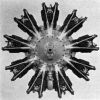 |
| 9Ra Algol (A39) |
The 9Ra Algol, a geared version with a 17:11 reduction ratio, was rated 300 hp at 1,900 rpm, weighed 322 kg (710 lb) and was 1,222 mm (48.11") long.
Another Algol version, equipped with mixing fan and 5.6:1 compression ratio, delivered 470 hp at 2,200 rpm. The 1937 9Ra Algol, a refined geared and supercharged model with a 6.0:1 compression ratio, was rated 430 hp at 2,300 rpm at 3,000 m (9,840 ft). A 6 to i was used, and the propeller reduction gears had a i i to 17 ratio. Dry weight was 349 kg (770 lb), diameter was 1,254 mm (49.37") and length was 1,346 mm (50.2").The Type 120 Algol was rated 500 hp at 2,400 rpm at 3000 m (9,840 ft). It had a 6.0:1 compression ratio, 17:11 propeller reduction ratio and a supercharger that ran at 8.66 times crankshaft speed. Fuel and oil consumptions were 0.583 and 0.033 lb/hp/hr. Dry weight was 389 kg (858 lb).
The 14L Antares was an air-cooled 14-cylinder radial with a 140 mm (5.512") bore, 150 mm (5.906") stroke, 20.782 l (1,268.17 in³) displacement and 5.0:1 compression ratio. Both direct-drive and geared (17:11) versions were rated 500 hp at 1,900 rpm. The direct drive version weighed 423 kg (933 lb), was 1,240 mm (48.82") in diameter and 1m424 mm (56.06") long. The geared version weighed 460 kg (1,014 lb) and was 1,552 mm (61.10") long. The Antares used a center main roller bearing whose outer race was supported in a plate that bolted to the central crankcase wall through an opening large enough to permit crankshaft insertion.
The 18Fo Sirius, an air-cooled 18-cylinder radial, was announced in 1936. With a 140 mm (5.512") bore, 166 mm (6.535") stroke, 45.997 l (2,806.89 in³) displacement, 5.0:1 compression ratio and 17:11 reduction ratio, it was rated 1,000 hp at 2,300 rpm at 4,000 m (13,123 ft). It weighed 676 kg (1,490 lb), was 1,300 mm (51.2") in diameter and 1,401 mm (55.16") long. The supercharger impeller turned at 9.1 tunes crankshaft speed. The aluminum alloy crankcase was forged in three sections. The four-piece crankshaft cone and key type joints and was carried on three bearings; a front double-row ball bearing took the thrust, and single-row roller bearings were center and aft. The one-piece master connecting rod had a floating bronze bushing. The link rod forked ends were supported by three eyes.
| Designation | Date | Config | Bore mm (in) | Stroke mm (in) | Displacement liter (in³) | Comp Ratio | Rated HP | RPM | Weight kg (lb) | Number Produced |
|---|---|---|---|---|---|---|---|---|---|---|
| Inline 6 | ||||||||||
| A.M. 6A | 1914 | I-6 | 120 (4.724) | 140 (5.512) | 9.500 (579.74) | 4.5 | 110 | 1,650 | 165 (364) | 200 |
| V-8 | ||||||||||
| 8Aa | 1915 | V-8 | 120 (4.724) | 140 (5.512) | 12.667 (772.98) | 150 | 1,500 | 15 | ||
| 8Aby | 1915 | V-8 | 120 (4.724) | 140 (5.512) | 12.667 (772.98) | 170 | 1,650 | 225 (496) | 300 | |
| 8Ba | 1917 | V-8 | 120 (4.724) | 170 (6.693) | 15.381 (938.62) | 220 | 1,650 | 245 (540) | 90 | |
| 8Bb | 1917 | V-8 | 120 (4.724) | 170 (6.693) | 15.381 (938.62) | 240 | 1,700 | 250 (551) | 30 | |
| 8Bd, 8Be | 1918 | V-8 | 120 (4.724) | 180 (7.087) | 16.286 (993.83) | 270 | 1,900 | 260 (573) | 50 | |
| Type 15-2 | 1917 | V-8 | 120 (4.724) | 180 (7.087) | 16.286 (993.83) | 5.2 | 270 | 1,650 | 289.4 (638) | |
| Type 16 | 1917 | V-8 | 120 (4.724) | 180 (7.087) | 16.286 (993.83) | 5.2 | 270 | 1,650 | 289.4 (638) | |
| V-12 | ||||||||||
| 12D | 1916 | V-12 | 120 (4.724) | 180 (7.087) | 24.429 (1,490.75) | 370 | 1,650 | 363 (800) | 50 | |
| 12Da | 1917 | V-12 | 120 (4.724) | 180 (7.087) | 24.429 (1,490.75) | 400 | 1,700 | 420 (926) | 400 | |
| 12Db | 1918 | V-12 | 120 (4.724) | 180 (7.087) | 24.429 (1,490.75) | 400 | 1,700 | 850 | ||
| 12Dc | 1919 | V-12 | 120 (4.724) | 180 (7.087) | 24.429 (1,490.75) | 370 | 100 | |||
| 12E | 1918? | V-12 | 120 (4.724) | 170 (6.693) | 23.072 (1,407.93) | 342 | 1,500 | |||
| Type 13 | 1918? | V-12 | 120 (4.724) | 175 (6.890) | 23.750 (1,449.34) | 400 | 1,600 | |||
| Type 17 | 1918? | V-12 | 120 (4.724) | 175 (6.890) | 23.750 (1,449.34) | 400 | 1,600 | 373 (822) | ||
| 1918? | V-12 | 120 (4.724) | 200 (7.874) | 27.143 (1,656.39) | 5.2 | 600 | 426 (939) | |||
| Type 18 | 1918? | V-12 | 120 (4.724) | 180 (7.087) | 24.429 (1,490.75) | 5.5 | 450 | 1,900 | 384 (847) | |
| 1918? | V-12 | 126 (4.961) | 200 (7.874) | 29.926 (1,826.17) | 500 | 1,600 | 460 (1,014) | |||
| 1926 | V-12 | 175 (6.890) | 225 (8.858) | 64.943 (3,963.04) | 700 | 1,200 | 848 (1,870) | |||
| 12Rcr Radium | 1930 | IV-12 | 145 (5.709) | 145 (5.709) | 28.733 (1,753.37) | 2,200 | 3,900 | 512 (1,129) | 3 | |
| 12Q | 1930 | V-12 | 170 (6.693) | 165 (6.496) | 44.942 (2,742.53) | 900 | 2,200 | 579 (1,276) | ||
| 12Hars Petrel | 1930 | V-12 | 145 (5.709) | 145 (5.709) | 28.733 (1,753.37) | 6.0 | 700 | 3,000 | 650 (1,433) | 65 |
| 12Hdrs Petrel | 1931 | V-12 | 145 (5.709) | 145 (5.709) | 28.733 (1,753.37) | 6.0 | 720 | 2,300 | 635 (1,400) | 350 |
| 12Hers Petrel | 1934 | V-12 | 145 (5.709) | 145 (5.709) | 28.733 (1,753.37) | 6.0 | 720 | 2,650 | 474 (1,045) | |
| 12Hfrs Petrel | 1935 | V-12 | 145 (5.709) | 145 (5.709) | 28.733 (1,753.37) | 7.0 | 815 | 2,800 | 650 (1,433) | 50 |
| 12Hgrs Petrel | 1935 | V-12 | 145 (5.709) | 145 (5.709) | 28.733 (1,753.37) | 7.0 | 815 | 2,800 | 650 (1,433) | 50 |
| 12Qo Eider | 1936 | V-12 | 170 (6.693) | 170 (6.693) | 46.304 (2,825.64) | 1,000 | 2,350 | 740 (1,631) | 5 | |
| 12R Sterna | 1936 | V-12 | 148 (5.827) | 148 (5.827) | 30.553 (1,864.47) | 1,000 | 2,800 | 600 (1,323) | 10 | |
| W-12 | ||||||||||
| Type 14 | 1918? | W-12 | 120 (4.724) | 170 (6.693) | 23.072 (1,407.93) | 358 | 1,500 | |||
| Type 15 | 1918? | W-12 | 120 (4.724) | 175 (6.890) | 23.750 (1,449.34) | 370 | 1,500 | 326.8 (720) | ||
| 12F | 1919 | W-12 | 126 (4.961) | 180 (7.087) | 26.933 (1,643.55) | 5.2 | 500 | 1,600 | 435 (959) | |
| 12Ew | 1919 | W-12 | 120 (4.724) | 180 (7.087) | 24.429 (1,490.75) | 420 | 1,800 | 390 (860) | ||
| 1918? | W-12 | 126 (4.961) | 200 (7.874) | 29.926 (1,826.17) | 500 | 1,600 | 435 (959) | |||
| 12Eb | 1922 | W-12 | 120 (4.724) | 180 (7.087) | 24.429 (1,490.75) | 6.0 | 450 | 1,850 | 373 (822) | >6000 |
| 12Ed | 1925 | W-12 | 120 (4.724) | 180 (7.087) | 24.429 (1,490.75) | 6.0 | 450 | 1,900 | 372 (820) | |
| 12Edr | 1925 | W-12 | 120 (4.724) | 180 (7.087) | 24.429 (1,490.75) | 6.0 | 450 | 1,900 | 412 (908) | |
| 12Ee | 1926 | W-12 | 120 (4.724) | 180 (7.087) | 24.429 (1,490.75) | 6.5 | 480 | 2,000 | 383 (844) | |
| 12F Courlis | 1928 | W-12 | 145 (5.709) | 160 (6.299) | 31.705 (1,934.75) | 6.0 | 600 | 2,000 | 423 (933) | 25 |
| 12Fa geared | 1928 | W-12 | 145 (5.709) | 160 (6.299) | 31.705 (1,934.75) | 6.0 | 600 | 2,000 | 450 (992) | |
| 12Fb geared | 1930 | W-12 | 145 (5.709) | 160 (6.299) | 31.705 (1,934.75) | 6.0 | 600 | 2,000 | 450 (992) | |
| 12E Hibis | 1932 | W-12 | 122 (4.803) | 180 (7.087) | 25.250 (1,540.86) | 6.0 | 500 | 2,000 | 390 (860) | |
| 12E Hibis | 1932 | W-12 | 122 (4.803) | 180 (7.087) | 25.250 (1,540.86) | 6.0 | 500 | 2,000 | 425 (937) | |
| W-24 | ||||||||||
| 12G | 1919 | W-24 | 126 (4.961) | 180 (7.087) | 53.866 (3,287.10) | 5.2 | 1,000 | 1,600 | 850 (1,874) | |
| 24W | 1929 | W-24 | 140 (5.512) | 150 (5.906) | 55.418 (3,381.80) | 1,000 | 2,500 | 990 (2,183) | 1 | |
| W-18 | ||||||||||
| 18Kb | 1927 | W-18 | 120 (4.724) | 180 (7.087) | 36.644 (2,236.13) | 6.0 | 650 | 2,000 | 584 (1,287) | 100 |
| 18Kd | 1927 | W-18 | 120 (4.724) | 180 (7.087) | 36.644 (2,236.13) | 6.0 | 650 | 2,000 | 619 (1,365) | |
| 18Ga Orion | 1929 | W-18 | 125 (4.921) | 180 (7.087) | 39.761 (2,426.35) | 6.0 | 700 | 2,100 | 568 (1,252) | 100 |
| 18G Super | 1934 | W-18 | 125 (4.921) | 180 (7.087) | 39.761 (2,426.35) | 6.0 | 1,050 | 2,150 | 627 (1,382) | |
| Radial | ||||||||||
| Model 47 | 1923 | R-7 | 135 (5.315) | 150 (5.906) | 15.030 (917.16) | 5.0 | 240 | 1,800 | 270 (595) | |
| Model 42 | 1924 | R-14 | 135 (5.315) | 150 (5.906) | 30.059 (1,834.32) | 5.0 | 470 | 1,800 | 439 (968) | |
| Model 49 | 1925 | R-5 | 125 (4.921) | 140 (5.512) | 8.590 (524.21) | 100 | 1,350 | 155 (342) | ||
| 7Ma, 7Mb | 1923 | R-7 | 140 (5.512) | 150 (5.906) | 16.163 (986.36) | 230 | 1,500 | 225 (496) | 30 | |
| 14Ac Antares | 1924 | R-14 | 140 (5.512) | 150 (5.906) | 32.327 (1,972.71) | 470 | 1,800 | 430 (948) | 15 | |
| 5Pa | 1925 | R-5 | 125 (4.921) | 140 (5.512) | 8.590 (524.21) | 5.0 | 100 | 1,350 | 156 (344) | 30 |
| 5Pb | 1926 | R-5 | 125 (4.921) | 140 (5.512) | 8.590 (524.21) | 5.0 | 110 | 1,650 | 158 (348) | 175 |
| 5Pc | 1927 | R-5 | 130 (5.118) | 140 (5.512) | 9.291 (566.99) | 5.5 | 120 | 1,700 | 161 (355) | 100 |
| 7Me Mizar | 1928 | R-7 | 140 (5.512) | 150 (5.906) | 16.163 (986.36) | 5.0 | 240 | 1,800 | 265 (584) | 90 |
| Mizar Major | 1928 | R-7 | 140 (5.512) | 150 (5.906) | 16.163 (986.36) | 6.0 | 330 | 2,100 | 265 (584) | |
| Super Mizar | 1928 | R-7 | 140 (5.512) | 150 (5.906) | 16.163 (986.36) | 5.6 | 300 | 2,100 | 265 (584) | |
| 9Na Algol | 1928 | R-9 | 140 (5.512) | 150 (5.906) | 20.782 (1,268.17) | 5.0 | 300 | 1,800 | 303 (668) | 250 |
| 9Ra Algol | 1928 | R-9 | 140 (5.512) | 150 (5.906) | 20.782 (1,268.17) | 5.0 | 300 | 1,900 | 322 (710) | |
| Type 120 Algol | 1937 | R-9 | 140 (5.512) | 150 (5.906) | 20.782 (1,268.17) | 6.0 | 430 | 2,300 | 389 (858) | |
| 14L Antares | 1932 | R-14 | 140 (5.512) | 150 (5.906) | 32.327 (1,972.71) | 5.0 | 500 | 1,900 | 423 (933) | |
| 14Lr Antares | 1937 | R-14 | 140 (5.512) | 150 (5.906) | 32.327 (1,972.71) | 5.0 | 500 | 1,900 | 460 (1,014) | |
| 18Fo | 1935 | R-18 | 140 (5.512) | 166 (6.535) | 45.997 (2,806.89) | 950 | 5 | |||
| 24E Taurus | 1938 | R-24 | 140 (5.512) | 150 (5.906) | 55.418 (3,381.80) | 1,600 | 3,000 | 5 | ||
| Note: This data comes from multiple, contradictory sources. Please use with caution and forward corrections or additions to the webmstr. | ||||||||||
References
Angle, Glenn D, ed. Aerosphere 1939 (New York, New York: Aircraft Publications, 1940).
Anble, Glenn D, ed. Airplane Engine Encyclopedia (Dayton, Ohio: Otterbein Press, 1921).
Les moteurs d’aviation Lorraine
Lorraine 1932 Engine Catalog (Members’ Section)
Pearce, William. "Lorraine-Dietrich ‘W’ Aircraft Engines" (Los Osos, California: Old Machine Press, 20 Dec 2019).
Image Sources: A39 = Aerosphere 1939; AEE = Airplane Engine Encyclopedia; Flt = Flight Magazine; NARA = U.S. National Archives and Records Administration; UKNA = United Kingdom National Archives.